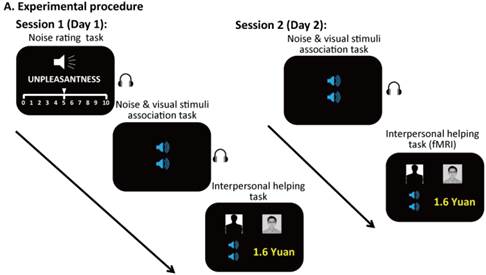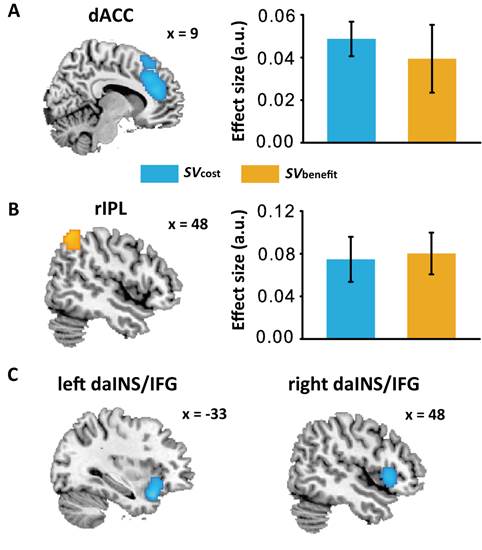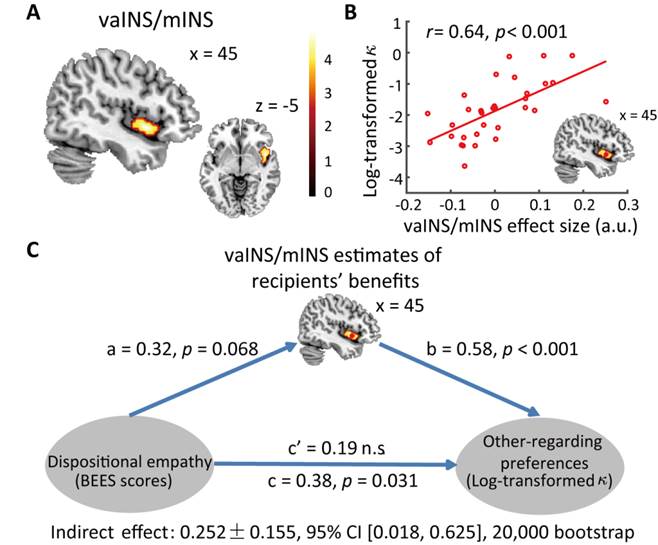On March 5, 2021, The Journal of Neuroscience published online a paper entitled “Computational and neurobiological substrates of cost-benefit integration in altruistic helping decision” by Prof. Xiaolin Zhou’s research group at the School of Psychological and Cognitive Sciences at Peking University and the PKU-IDG/McGovern Institute for Brain Research. This study provides a neurocomputational account of how people weigh between different attributes to make altruistic decisions and why altruistic preference varies to a great extent across individuals.
Altruistic behavior, i.e., sacrificing ones’ own interests to boost others’ welfare, is a fundamental type of social behaviors in animal and human societies. It is widely seen in interpersonal interactions even in situations without any opportunities for reciprocity between strangers. However, it is also found that people are not always willing to help others at their own costs. On the one hand, cost-reward model assumed that people deliberately weigh between the benefit and the cost when deciding whether to behave altruistically, and variations in such weighing processes (i.e., other-regarding preferences) across contexts, tasks, and individuals further lead to great variations in altruistic behaviors. On the other hand, the empathy-altruism hypothesis emphasizes that individuals with stronger empathic concern disposition are willing to incur higher costs to help others. However, due to the lack of quantitative investigation of the underlying neural substrates, it is still unclear how individuals make altruistic or selfish decisions involving the trade-off between self- and other-interests, how such decision processes are implemented in the brain, and whether and how the cost-benefit integration (i.e., the task-specific other-regarding preference) is linked to individuals’ dispositional personality (i.e., empathy concern).
In this study, Xiaolin Zhou’s group combined a novel interpersonal helping task (Figure 1) with computational modeling and functional magnetic resonance imaging (fMRI) to address the above issues. In each trial of the interpersonal helping task, the participant decided whether or not to forgo a certain amount of money from the participation payments to help one anonymous partner avoid a 30-second clip of noise stimulus. The authors manipulated the costs and benefits of helping behavior by orthogonally varying participants’ cost amounts and the unpleasantness levels of the noise that would be exempted for the partner.

Figure 1. Experimental procedure
Computational modeling analyses suggested that individuals are likely to integrate their own monetary costs with nonlinearly transformed recipients’ benefits, which generalized the integration with nonlinear transformations in non-social decision-making to social decision-making, and extended algorithms of altruistic decision-making from linear integration to integration with nonlinear transformations. Neuroimaging results demonstrate the involvement of an extended common currency system during decision-making by showing that selfish and other-regarding motives were processed in dorsal anterior cingulate cortex (dACC) and right inferior parietal lobule (rIPL) in a domain-general manner. In addition, dorsal anterior insular cortex and inferior frontal gyrus (daINS/IFG) were only involved in valuation of benefactors’ costs (Figure 2).

Figure 2. Activities in dorsal anterior cingulate cortex (dACC, A) and right inferior parietal lobule (rIPL, B) are associated with both monetary cost amount and physical benefits. Activities in bilateral dorsal anterior insular cortex and inferior frontal gyrus (daINS/IFG, C) are only associated with cost amount.
To further explore the neural mechanisms underlying individual differences in altruistic behavior, researchers performed mediation analyses and inter-subject representational similarity analyses (IS-RSA). Mediation analyses suggested that stronger dispositional empathy would indeed increase altruistic preferences, and that ventral anterior insular/middle insular (vaINS/mINS) fully mediated the effect of dispositional empathy on cost-benefit calculation during altruistic decision-making (Figure 3). And IS-RSA further revealed that individuals with higher representational similarity in vaINS/mINS and dorsal lateral prefrontal cortex (DLPFC) would exhibit more similar altruistic preferences. Together, these findings suggested that vaINS/mINS and daINS/IFG, as two adjacent but different sub-regions within insular cortex, were involved in distinct sub-functions underlying altruistic decision making.

Figure 3. ventral anterior insular/ middle insular (vaINS/mINS) fully mediate the effect of dispositional empathy on cost-benefit calculation during altruistic decision-making.
In summary, this study provided a neurocomputational account of how different attributes are integrated to support altruistic helping behavior, which highlighted the importance of nonlinear algorithm in cost-benefit integration of altruistic behavior. These findings also shed new lights on future investigations of psychological and neurobiological bases underlying complex interpersonal interactive behaviors.
The first author of thi stuy is Dr. Jie Hu, a previous PhD student in Xiaolin Zhou’s group. Dr. Yang Hu, a postdoctoral fellow in Xiaolin Zhou’s group, and Ms. Yue Li, a PhD student in Xiaolin Zhou’s group, also made important contributions to the current study. This study was supported by National Natural Science Foundation of China. Dr. Jie Hu was also supported by the European Research Council (ERC) under the European Union’s Horizon 2020 research and innovation programme.


